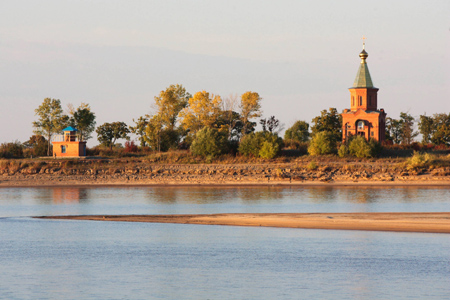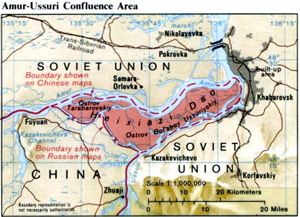Bolshoy Ussuriysky Island
Heixiazi Dao (Chinese黑 瞎子 岛/黑 瞎子 岛, pinyin Hēixiāzǐ Dǎo, literally " Asiatic Black Island ", also: Chinese抚远 三角洲/抚远 三角洲, Pinyin Fǔyuǎn Sānjiǎo Zhou, " Fuyuaner triangle island "; Russian Большой Уссурийский, ie Bolshoi Ussurijski island; Manjurisch: Morin Uju, ie " horse head ") is a three-piece island in Fuyuan county of the prefecture-level city of Jiamusi in northeast China's Heilongjiang Province and a part in the Russian region of Khabarovsk. It was traditional and undisputed Chinese territory, until the Soviet Union occupied it in 1929 taking advantage of the internal political turmoil in China. In the " Supplementary Agreement on the Eastern part of the Chinese- Russian border between the People's Republic of China and the Russian Federation" of 14 October 2004, Russia pledged to return the western half of Heixiazi Dao in China. China agreed in return not to raise the demand for the return of the eastern part of the island and recognize the resulting boundary as binding under international law. After extensive surveying and demarcation of a mixed Sino- Russian commission the return October 14, 2008 was completed. In the Chinese part of the island two nature reserves have now been created and created the infrastructure for intensive tourism.
Geography
Heixiazi Dao is elongated in the middle reaches of the Heilong Jiang ( Amur ) directly in front of the mouth of the Ussuri, which, coming from the south meets approximately centrally on the island and is deflected by it in an easterly direction. Coming from the west meets only a small tributary of the Heilong Jiang, Tongjiangzi (通 江 子), on the Ussuri, the first of about 30 km eastward flowing past the island, only to turn directly in front of the center of Khabarovsk north again, where it directly to the main stream of the Heilong Jiang, who hit him from the west, united. The three parts of the island, which are separated only by narrow, low-flow river branches, hot Yinlong Dao (Chinese银龙 岛/银龙 岛, pinyin Yinlong Dǎo, literally " Silver Dragon Island " ), Heixiazi Dao and MINGYUE Dao (Chinese明 月 岛/明月 岛, pinyin MINGYUE Dǎo, literally: "Bright moon island" ). They are surrounded by about 90 small and very small Flussinselchen whose main Xiaohe Dao (小河 岛), Feng Dao (枫 岛), Juhua Dao (菊花 岛), Dongjia Dao (东家 岛), Qi Dao (旗 岛), and Jiuliang Dao (久 良 岛) are. The total land area of the three -part main island and the small adjoining islands is during the dry season around 350 km ² at high tide only about 327 km ². From west to east Heixiazi Dao extends over 58.85 km, the largest north-south extension in the center of the island is just over 14 km. The highest peaks of the island do not exceed 40 meters. The new international border runs north- south on the central part of the island, so that the western Yinlong Dao was completely returned to China, while the eastern MINGYUE Dao completely remained in Russia. The eponymous central part of the island is divided in the west in a slightly larger Russian part of the east and slightly smaller in Chinese. This was one of only two places where the Sino- Russian land border is on an island. The land area of the returned to China part of the Heixiazi Dao is about 172 square kilometers at average water level.









